Page 278 of 426
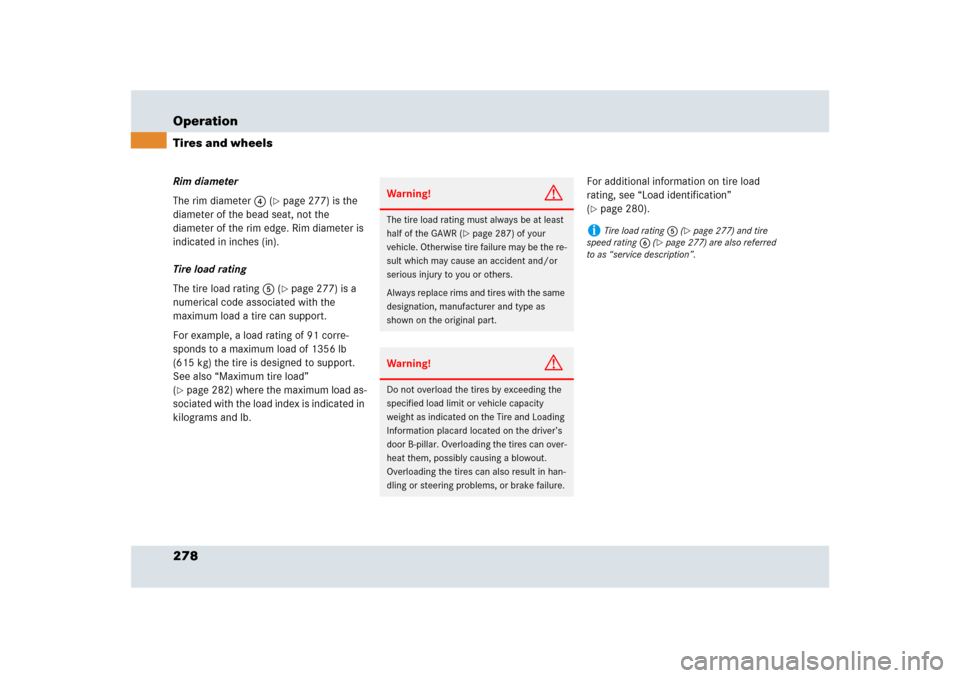
278 OperationTires and wheelsRim diameter
The rim diameter4 (
�page 277) is the
diameter of the bead seat, not the
diameter of the rim edge. Rim diameter is
indicated in inches (in).
Tire load rating
The tire load rating5 (�page 277) is a
numerical code associated with the
maximum load a tire can support.
For example, a load rating of 91 corre-
sponds to a maximum load of 1356 lb
(615 kg) the tire is designed to support.
See also “Maximum tire load”
(
�page 282) where the maximum load as-
sociated with the load index is indicated in
kilograms and lb.For additional information on tire load
rating, see “Load identification”
(
�page 280).
Warning!
G
The tire load rating must always be at least
half of the GAWR (
�page 287) of your
vehicle. Otherwise tire failure may be the re-
sult which may cause an accident and/or
serious injury to you or others.
Always replace rims and tires with the same
designation, manufacturer and type as
shown on the original part.
Warning!
G
Do not overload the tires by exceeding the
specified load limit or vehicle capacity
weight as indicated on the Tire and Loading
Information placard located on the driver’s
door B-pillar. Overloading the tires can over-
heat them, possibly causing a blowout.
Overloading the tires can also result in han-
dling or steering problems, or brake failure.
i
Tire load rating5 (
�page 277) and tire
speed rating6 (
�page 277) are also referred
to as “service description”.
Page 279 of 426
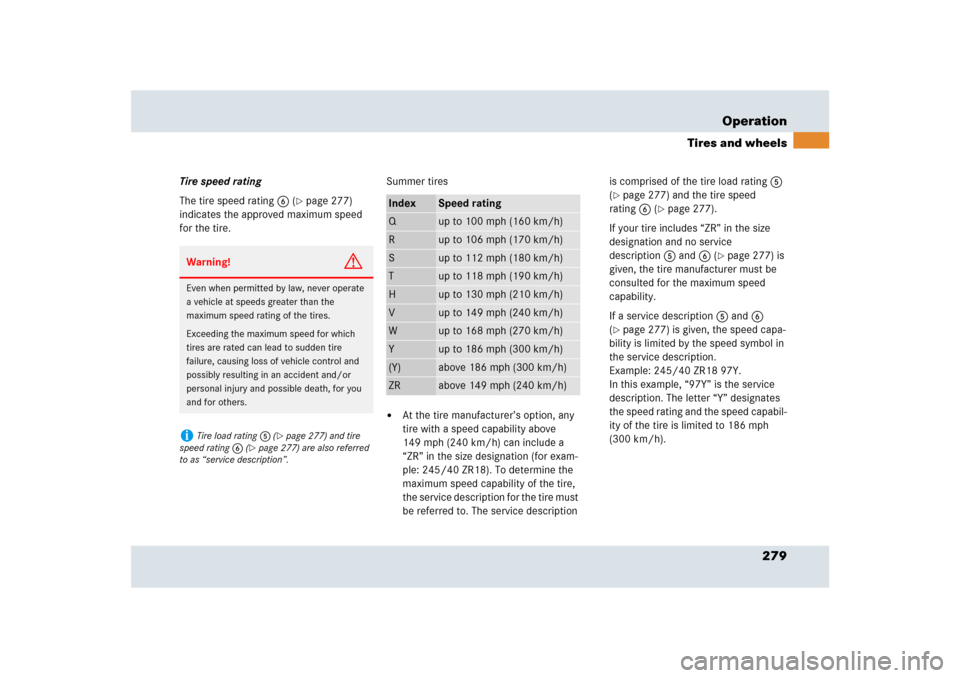
279 Operation
Tires and wheels
Tire speed rating
The tire speed rating6 (
�page 277)
indicates the approved maximum speed
for the tire.Summer tires
�
At the tire manufacturer’s option, any
tire with a speed capability above
149 mph (240 km/h) can include a
“ZR” in the size designation (for exam-
ple: 245/40 ZR18). To determine the
maximum speed capability of the tire,
the service description for the tire must
be referred to. The service description is comprised of the tire load rating5
(
�page 277) and the tire speed
rating6 (
�page 277).
If your tire includes “ZR” in the size
designation and no service
description5 and6 (
�page 277) is
given, the tire manufacturer must be
consulted for the maximum speed
capability.
If a service description5 and6
(
�page 277) is given, the speed capa-
bility is limited by the speed symbol in
the service description.
Example: 245/40 ZR18 97Y.
In this example, “97Y” is the service
description. The letter “Y” designates
the speed rating and the speed capabil-
ity of the tire is limited to 186 mph
(300 km/h).
Warning!
G
Even when permitted by law, never operate
a vehicle at speeds greater than the
maximum speed rating of the tires.
Exceeding the maximum speed for which
tires are rated can lead to sudden tire
failure, causing loss of vehicle control and
possibly resulting in an accident and/or
personal injury and possible death, for you
and for others.i
Tire load rating5 (
�page 277) and tire
speed rating6 (
�page 277) are also referred
to as “service description”.
Index
Speed rating
Q
up to 100 mph (160 km/h)
R
up to 106 mph (170 km/h)
S
up to 112 mph (180 km/h)
T
up to 118 mph (190 km/h)
H
up to 130 mph (210 km/h)
V
up to 149 mph (240 km/h)
W
up to 168 mph (270 km/h)
Y
up to 186 mph (300 km/h)
(Y)
above 186 mph (300 km/h)
ZR
above 149 mph (240 km/h)
Page 280 of 426
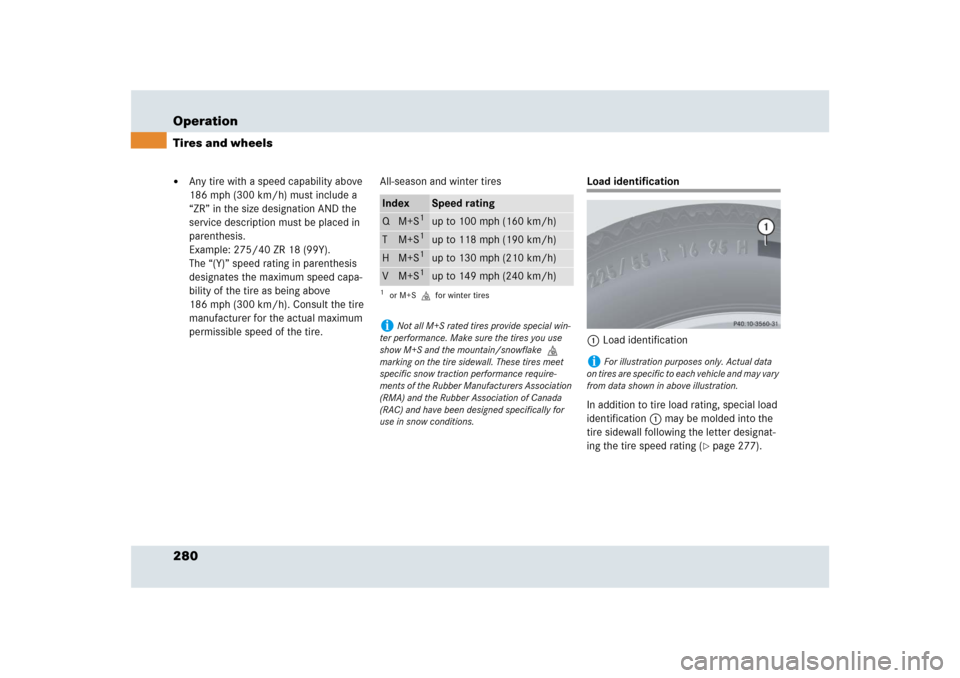
280 OperationTires and wheels�
Any tire with a speed capability above
186 mph (300 km/h) must include a
“ZR” in the size designation AND the
service description must be placed in
parenthesis.
Example: 275/40 ZR 18 (99Y).
The “(Y)” speed rating in parenthesis
designates the maximum speed capa-
bility of the tire as being above
186 mph (300 km/h). Consult the tire
manufacturer for the actual maximum
permissible speed of the tire.All-season and winter tires
Load identification
1Load identification
In addition to tire load rating, special load
identification1 may be molded into the
tire sidewall following the letter designat-
ing the tire speed rating (
�page 277).
Index
Speed rating
QM+S
1
1or M+S.for winter tires
up to 100 mph (160 km/h)
TM+S
1
up to 118 mph (190 km/h)
HM+S
1
up to 130 mph (210 km/h)
VM+S
1
up to 149 mph (240 km/h)
i
Not all M+S rated tires provide special win-
ter performance. Make sure the tires you use
show M+S and the mountain/snowflake.
marking on the tire sidewall. These tires meet
specific snow traction performance require-
ments of the Rubber Manufacturers Association
(RMA) and the Rubber Association of Canada
(RAC) and have been designed specifically for
use in snow conditions.
i
For illustration purposes only. Actual data
on tires are specific to each vehicle and may vary
from data shown in above illustration.
Page 281 of 426
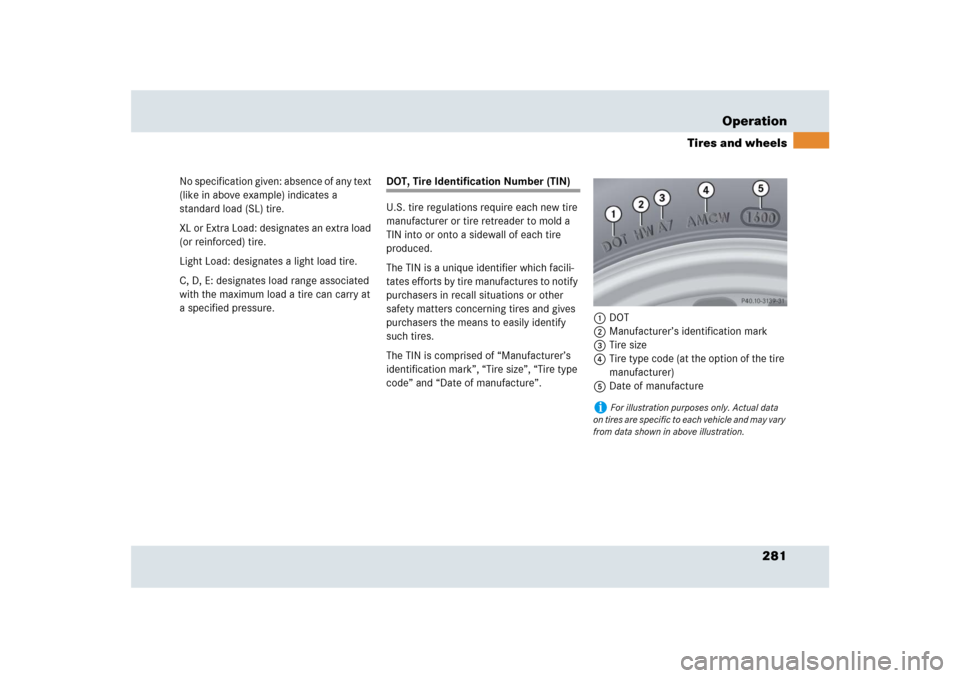
281 Operation
Tires and wheels
No specification given: absence of any text
(like in above example) indicates a
standard load (SL) tire.
XL or Extra Load: designates an extra load
(or reinforced) tire.
Light Load: designates a light load tire.
C, D, E: designates load range associated
with the maximum load a tire can carry at
a specified pressure.
DOT, Tire Identification Number (TIN)
U.S. tire regulations require each new tire
manufacturer or tire retreader to mold a
TIN into or onto a sidewall of each tire
produced.
The TIN is a unique identifier which facili-
tates efforts by tire manufactures to notify
purchasers in recall situations or other
safety matters concerning tires and gives
purchasers the means to easily identify
such tires.
The TIN is comprised of “Manufacturer’s
identification mark”, “Tire size”, “Tire type
code” and “Date of manufacture”.1DOT
2Manufacturer’s identification mark
3Tire size
4Tire type code (at the option of the tire
manufacturer)
5Date of manufacture
i
For illustration purposes only. Actual data
on tires are specific to each vehicle and may vary
from data shown in above illustration.
Page 282 of 426
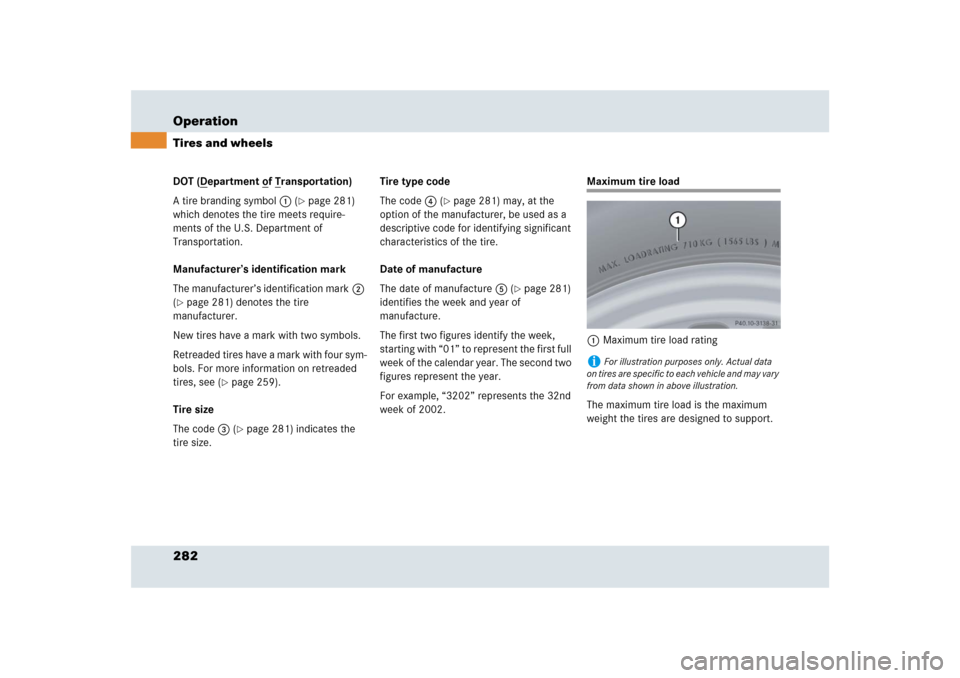
282 OperationTires and wheelsDOT (D
epartment o
f T
ransportation)
A tire branding symbol1 (
�page 281)
which denotes the tire meets require-
ments of the U.S. Department of
Transportation.
Manufacturer’s identification mark
The manufacturer’s identification mark2
(
�page 281) denotes the tire
manufacturer.
New tires have a mark with two symbols.
Retreaded tires have a mark with four sym-
bols. For more information on retreaded
tires, see (
�page 259).
Tire size
The code3 (�page 281) indicates the
tire size.Tire type code
The code4 (
�page 281) may, at the
option of the manufacturer, be used as a
descriptive code for identifying significant
characteristics of the tire.
Date of manufacture
The date of manufacture5 (
�page 281)
identifies the week and year of
manufacture.
The first two figures identify the week,
starting with “01” to represent the first full
week of the calendar year. The second two
figures represent the year.
For example, “3202” represents the 32nd
week of 2002.
Maximum tire load
1Maximum tire load rating
The maximum tire load is the maximum
weight the tires are designed to support.i
For illustration purposes only. Actual data
on tires are specific to each vehicle and may vary
from data shown in above illustration.
Page 283 of 426
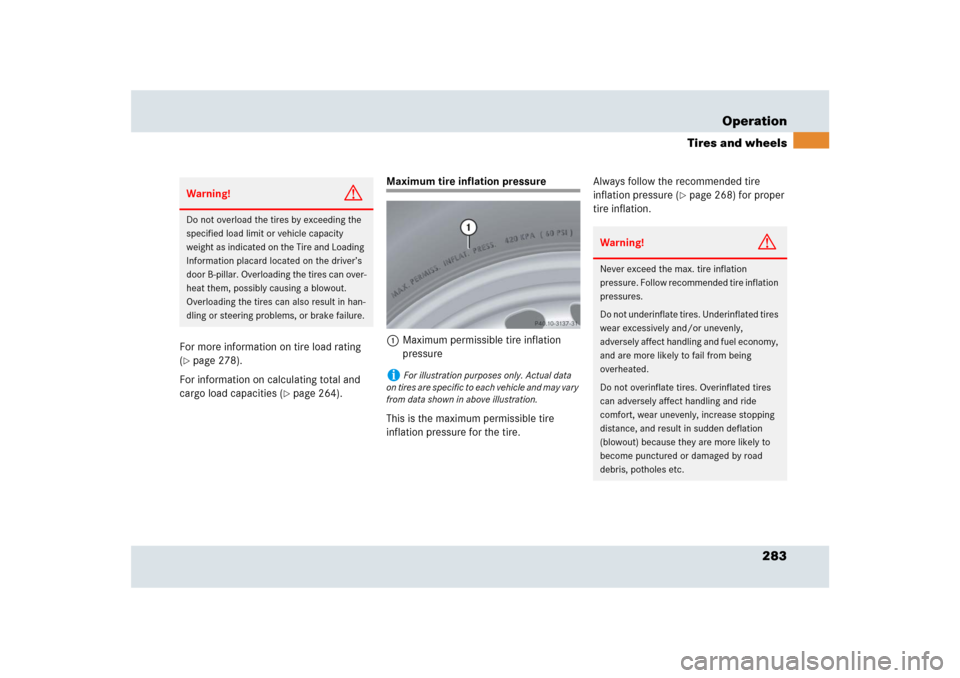
283 Operation
Tires and wheels
For more information on tire load rating
(�page 278).
For information on calculating total and
cargo load capacities (
�page 264).
Maximum tire inflation pressure
1Maximum permissible tire inflation
pressure
This is the maximum permissible tire
inflation pressure for the tire.Always follow the recommended tire
inflation pressure (
�page 268) for proper
tire inflation.
Warning!
G
Do not overload the tires by exceeding the
specified load limit or vehicle capacity
weight as indicated on the Tire and Loading
Information placard located on the driver’s
door B-pillar. Overloading the tires can over-
heat them, possibly causing a blowout.
Overloading the tires can also result in han-
dling or steering problems, or brake failure.
i
For illustration purposes only. Actual data
on tires are specific to each vehicle and may vary
from data shown in above illustration.
Warning!
G
Never exceed the max. tire inflation
pressure. Follow recommended tire inflation
pressures.
Do not underinflate tires. Underinflated tires
wear excessively and/or unevenly,
adversely affect handling and fuel economy,
and are more likely to fail from being
overheated.
Do not overinflate tires. Overinflated tires
can adversely affect handling and ride
comfort, wear unevenly, increase stopping
distance, and result in sudden deflation
(blowout) because they are more likely to
become punctured or damaged by road
debris, potholes etc.
Page 284 of 426

284 OperationTires and wheelsUniform Tire Quality Grading Standards (U.S. vehicles)
Tire manufacturers are required to grade
tires based on three performance
factors: treadwear, traction and
temperature resistance.
1Treadwear
2Traction
3Temperature resistanceQuality grades can be found, where appli-
cable, on the tire sidewall between tread
shoulder and maximum section width. For
example:
All passenger car tires must conform to
federal safety requirements in addition to
these grades.Treadwear
The treadwear grade is a comparative rat-
ing based on the wear rate of the tire when
tested under controlled conditions on a
specified government test course. For ex-
ample, a tire graded 150 would wear one
and one-half (1
1/2) times as well on the
government course as a tire graded 100.
The relative performance of tires depends
upon the actual conditions of their use,
however, and may depart significantly
from the norm due to variations in driving
habits, service practices and differences in
road characteristics and climate.
i
For illustration purposes only. Actual data
on tires are specific to each vehicle and may vary
from data shown in above illustration.
Treadwear
Traction
Temperature
200
AA
A
Page 285 of 426

285 Operation
Tires and wheels
Traction
The traction grades, from highest to low-
est, are AA, A, B, and C. Those grades rep-
resent the tire’s ability to stop on wet
pavement as measured under controlled
conditions on specified government test
surfaces of asphalt and concrete. A tire
marked C may have poor traction
performance.Temperature
The temperature grades are A (the high-
est), B, and C, representing the tire’s resis-
tance to the generation of heat and its
ability to dissipate heat when tested under
controlled conditions on a specified indoor
laboratory test wheel. Sustained high tem-
perature can cause the material of the tire
to degenerate and reduce tire life, and ex-
cessive temperature can lead to sudden
tire failure. The grade C corresponds to a
level of performance which all passenger
car tires must meet under the Federal
Motor Vehicle Safety Standard No. 109.
Grades B and A represent higher levels of
performance on the laboratory test wheel
than the minimum required by law.Warning!
G
The traction grade assigned to this tire is
based on straight-ahead braking traction
tests, and does not include acceleration,
cornering, hydroplaning, or peak traction
characteristics.
Warning!
G
The temperature grade for this tire is
established for a tire that is properly inflated
and not overloaded. Excessive speed,
underinflation, or excessive loading, either
separately or in combination, can cause
excessive heat build-up and possible tire
failure.